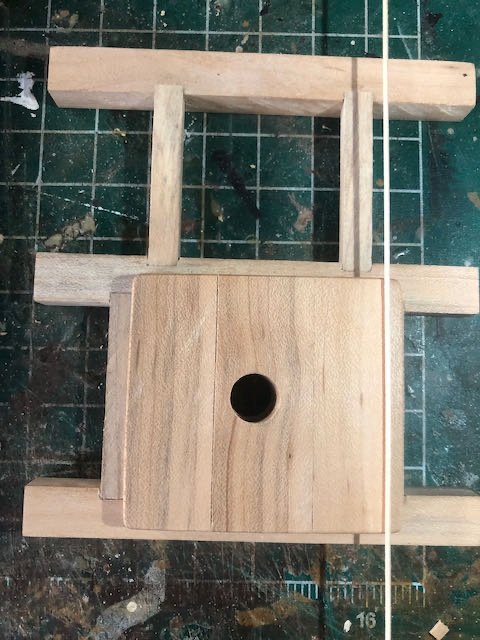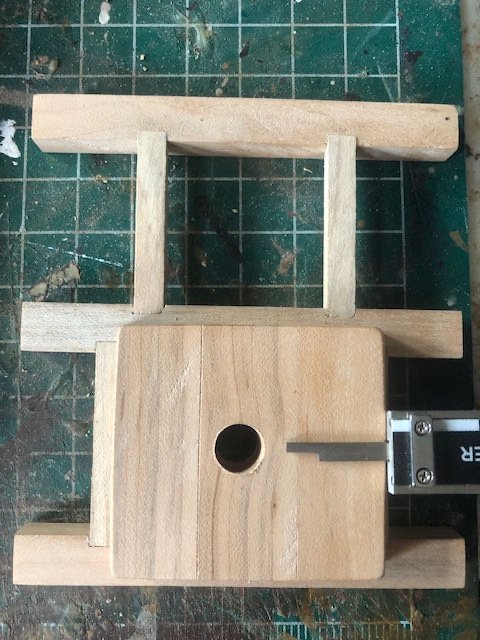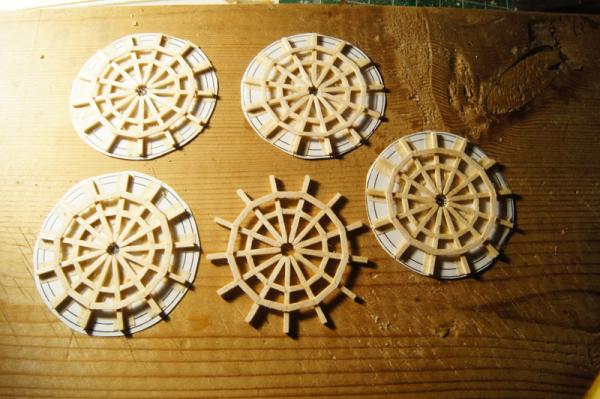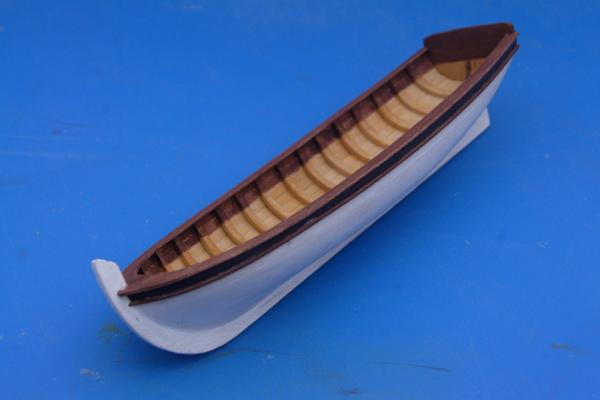-
Posts
3,418 -
Joined
-
Last visited
Content Type
Profiles
Forums
Gallery
Events
Everything posted by Cathead
-
So I have been feeling fine this week. Really have no idea what to think about what happened last week. But I've been back working on the capstan this weekend. I will have some nice progress to show on the grating soon, but first I need to share what at first felt like a disastrous mistake, but which I think I found a solution to. I decided to drill the hole for the spindle in the base. I measured it carefully to get it perfectly centered, and used a drill guide to make sure everything was straight and steady. Yet somehow the drill slipped sideways and I ended up with this: The caliper is set to the distance from the left side of the base to the left side of the hole, so here it's showing the amount of offset to the left. It's also pretty obvious simply by eye. This would be really ugly as the capstan would blatantly sit off-center. This felt so awful, I just wasn't up for remaking this entire assemblage. My proposed solution, for which I'm interested in feedback, is to cut an appropriate amount off the right side of the base to restore symmetry. I don't think the narrower base will be noticeable, and based on my measurements it'll still overlap the carlings. So in the photo below, the thin batten shows where I'd cut off the right side: Is this the best fix? Is there another approach I haven't thought of? Thanks for any feedback.
-
Congratulations! You'll enjoy looking at that once you find the right space.
- 10 replies
-
- Viking Longboat
- Artesania Latina
-
(and 1 more)
Tagged with:
-
On my Bertrand I build each of the five assemblages on a separate template, and seem to have managed ok. It helped that Bertrand's wheel only had 13 spokes. For Arabia's wheels, I laid things out similarly but used pins to help hold pieces in place: I then built subsequent wheels right on top the first to try and minimize variation: Even so I still had trouble getting things to line up, but it's hard to notice in the finished model with so much else going on visually. As I said above, I marked the end of one spoke on each assemblage to remember how things aligned. Here's a link to where my wheel-building discussion starts in the Arabia log if you want to consult more details.
- 238 replies
-
- Robert E Lee
- steamboat
- (and 3 more)
-
Exact same problem I had. No matter how careful I was, it was nigh-on impossible to get every spoke lined up, even when I tried marking a single line of spokes so I could keep them all aligned. Tiny variations ripple through and are maddening!
- 238 replies
-
- Robert E Lee
- steamboat
- (and 3 more)
-
I've made no further progress. My first try at making gratings failed, but before I got much further on a next attempt, several things intervened. First, I had an especially busy stretch where I often ended up especially tired in the evening and not up for focusing on the project. Honestly, one thing I wasn't expecting (or hadn't thought through) was that this project is very power-tool based, without much hand work. Basically each step is laying out and cutting a complicated piece on the table saw, before a brief bit of final sanding and assembly. The amount of precision needed takes it out of the hand-tool realm, at least for me. To be honest, one of the things I've liked most about getting into wooden modeling IS the hand-craft nature of it; I don't particularly enjoy using power tools, with their noise, dust, dedicated isolated workshop space, and increased danger. I'm happiest puttering away at my modeling table in the main part of the house where I can talk to my wife and be part of household life. So I've already noticed that I'm spending most of my time in this project in the cold garage workshop focusing on safe table saw use, which isn't a core enjoyment for me. I think that pattern is cutting into my dedication, and making it easier to put off working on it any given night if I'm at all tired or unmotivated (from a safety perspective, if nothing else). Second, in the past week I've become increasingly convinced that I have omicron, from a collective feeling of fatigue, lack of concentration, dry cough, runny nose, sore throat, etc. None of which are bad on their own and might even be dismissed normally, but given the sheer wave of infections hitting the US right now, and the perfect overlap of these feeling with the most commonly reported symptoms, it seems likely (not getting tested as that would mean a 45-minute round trip to a site that, according to media, has outdoor lines wrapping around the building in mid-winter, no thanks). I don't want to go anywhere near power tools while feeling fatigued or diminished, so that puts off the project for a while. In fact, one of the earliest (in retrospect) signs that I might have been getting sick was a series of minor accidents/mistakes made while doing outdoor chainsaw work and wood-chipping early in the week; my wife noticed that I was being unusually clumsy or gaffe-prone and we eventually stopped when the pattern became clear. So I don't know when I'll get back to this. I'm not giving up on it, it's just not serving my needs and situation right now. I'm not personally worried about the disease, I'm a very active and healthy young 40s with none of the comorbidities linked to severe covid (though not boosted since I had a severe cardiac reaction to mRNA the first two doses and no other options are available in the US), so expect to recover in another week or so. Thanks for your patience, and good health to you all.
-
It's also worth noting that the series has also been released several times in audiobook format, and I've listened through each. In my opinion, the version with Simon Vance narrating is absolutely fantastic; he captures the characters, dialogue, dialects, and tone of the series perfectly. The version with Patrick Tull as narrator is serviceable, but I don't feel that his narrative choices seem as right; Aubrey comes across as too upper-class patrician, and Maturin is almost an Irish caricature. I feel like Tull is simply reading yet another story, while Vance actually understands and appreciates what he's reading. Others' opinions may vary, of course. Listening to the series really lets you immerse yourself in the world, letting it go by at a reader's pace. If you're fortunate, your local library has them in physical or digital form; I've been able to download both versions that way.
-
- 28 replies
-
- 18th Century Longboat
- Model Shipways
-
(and 2 more)
Tagged with:
-
I used several sanding drums, once that was cylindrical, and one that was somewhat conical. The latter made it easier to get the tool into awkward spaces.
- 28 replies
-
- 18th Century Longboat
- Model Shipways
-
(and 2 more)
Tagged with:
-
Nice start! Have you already glued the sides on or are you still test-fitting? If they're still loose, you might consider fully fairing the bulkheads near the bow, so that the entire edge is at an angle (i.e., when all the laser char is removed). This will give you more contact surface for gluing. Otherwise disregard. Have fun building what is, as you say, a popular model.
- 132 replies
-
- King of the Mississippi
- Artesania Latina
-
(and 1 more)
Tagged with:
-
Herzliche Willkommen! Sind Sie niederländisch, oder vielleicht südafrikanisch (dein Name scheint zu sein)? Your English seems plenty good enough to communicate here. I look forward to your next model.
-
Nice progress! If you use a Dremel to sand those frames down, make sure both the model and your hand are well-braced and steady. I kept my wrist anchored on something and only moved the tool with small motions of my fingers. Even at the slowest Dremel speed it's awfully easy for a quick jerk or slip to gouge something you don't want, or to go too far. It'll definitely make the job much easier and faster, but with a corresponding risk factor. You might even consider practicing on some scrap first (like the wood sheets from which the frames were cut) to get a feel for the pressure and steadiness needed. Can't speak to the other tool you mentioned.
- 28 replies
-
- 18th Century Longboat
- Model Shipways
-
(and 2 more)
Tagged with:
-
I love seeing the structure take shape. I've always found building paddle wheels maddening, good luck to you!
- 238 replies
-
- Robert E Lee
- steamboat
- (and 3 more)
-
Best thing you can do is keep this log updated with what you're doing and what questions you may have, that way people can give you direct advice. That, and browse the help sections here. There are some particularly good planking tutorials, and that's someone many beginners struggle with as it's not always intuitive. Good luck and stay active here!
- 8 replies
-
- first build
- Artesania Latina
-
(and 1 more)
Tagged with:
-
Parts look great so far. Will be fun to watch a master at work on such a high-end kit.
- 488 replies
-
- Indefatigable
- Vanguard Models
-
(and 1 more)
Tagged with:
-
Thank you, Mark. Grant, I should have credited you, I saw that in your log and decided it gave me cover to do likewise.
-
Nice work so far! If I may make a respectful suggestion, perhaps you'd consider editing the title of your build log to spell the ship's name correctly (Beagle rather than Beagel) as well as that of the manufacturer (OcCre rather than ocre)? Normally I wouldn't worry about misspellings, but in this case getting them right would help more people find your build if they're searching for such terms.
About us
Modelshipworld - Advancing Ship Modeling through Research
SSL Secured
Your security is important for us so this Website is SSL-Secured
NRG Mailing Address
Nautical Research Guild
237 South Lincoln Street
Westmont IL, 60559-1917
Model Ship World ® and the MSW logo are Registered Trademarks, and belong to the Nautical Research Guild (United States Patent and Trademark Office: No. 6,929,264 & No. 6,929,274, registered Dec. 20, 2022)
Helpful Links
About the NRG
If you enjoy building ship models that are historically accurate as well as beautiful, then The Nautical Research Guild (NRG) is just right for you.
The Guild is a non-profit educational organization whose mission is to “Advance Ship Modeling Through Research”. We provide support to our members in their efforts to raise the quality of their model ships.
The Nautical Research Guild has published our world-renowned quarterly magazine, The Nautical Research Journal, since 1955. The pages of the Journal are full of articles by accomplished ship modelers who show you how they create those exquisite details on their models, and by maritime historians who show you the correct details to build. The Journal is available in both print and digital editions. Go to the NRG web site (www.thenrg.org) to download a complimentary digital copy of the Journal. The NRG also publishes plan sets, books and compilations of back issues of the Journal and the former Ships in Scale and Model Ship Builder magazines.











